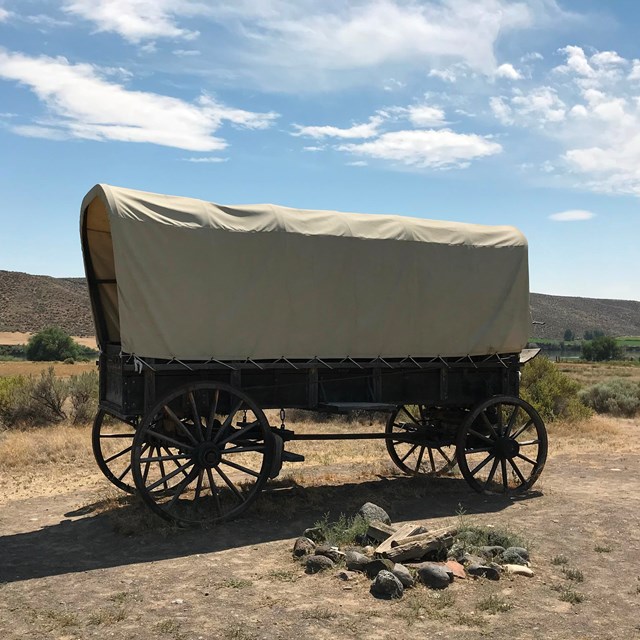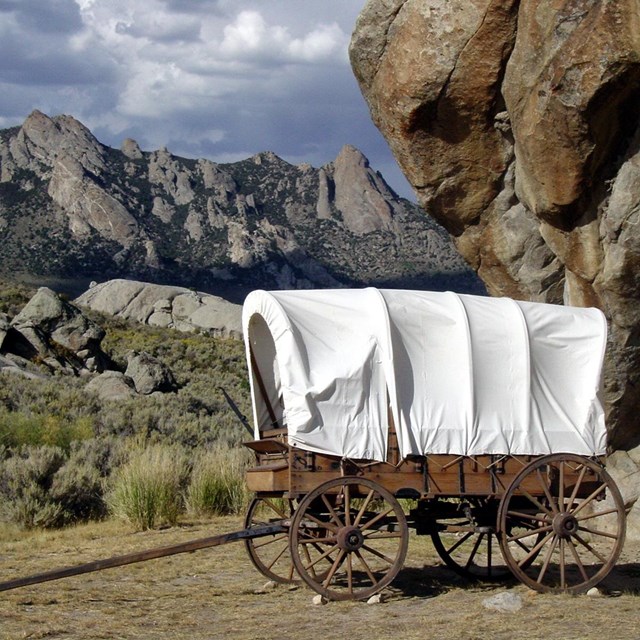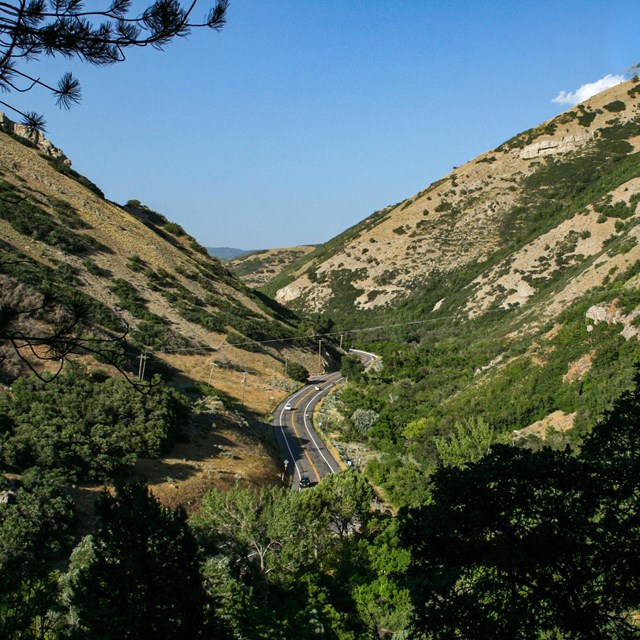Last updated: March 28, 2022
Article
Chapter 1: Race, Slavery, and Freedom - Permanent, Hereditary Chattel: A Snapshot of Antebellum Slavery in the South, Indian Territory, and Border States
Sweet Freedom's Plains
African Americans on the Overland Trails 1841-1869
By Shirley Ann Wilson Moore, PhD.
For the National Park Service
National Trails Regions 6, 7, & 8
Introduction/Table of Contents
Chapter 1 Sections
- The Early Black Presence
- The Question of Race
- The Evolution of Their Status
- The Contagion of Liberty
- Permanent, Hereditary Chattel: A Snapshot of Antebellum Slavery in the South, Indian Territory, and Border States
- Northern “Unfreedom”
- The Nature of Freedom in the West
- Utah: Slaves and Saints
- No Rights to be Respected
After the Revolution, a great deal of the new nation’s economic prosperity was dependent on slave labor, and the majority of African Americans resided in the South as slaves. Four million men, women, and children lived under a system of chattel slavery that dominated every aspect of their lives. While each southern state had its own set of slave codes, all followed a common pattern. Most prohibited slave gatherings (including religious services) without white supervision, forbade teaching slaves to read, and prohibited them from bearing firearms, legally marrying, or traveling without the written permission of their owners or overseers.
Free blacks in the South, although they did not have owners, were nonetheless far from free. Most Southern black codes placed the burden of proof of freedom on the black person. Failure to prove free status could result in enslavement. This was also the case for failure to pay debts, court fines, or taxes. Black laws prevented free black southerners from voting, holding office, or testifying in court against a white person. Georgia laws barred free blacks from owning property.26
In the early national era, slavery became more deeply entrenched in the South and gradually faded out in the North. In 1793, the introduction of the cotton gin caused a boom in cotton production and rapidly expanded southern slavery beyond the Appalachian Mountains. The success of Eli Whitney’s cotton gin encouraged slaveholders to try their hand at growing cotton in southern Missouri in the early 1800s. Other planters brought in slaves, mostly from Kentucky, Virginia, Tennessee, and North Carolina, to grow other crops in areas that could not support cotton. By 1810 there were 3,011 slaves and 607 free blacks living in Missouri Territory; the 1820 census recorded 97,797 “bondsmen” and 376 black freemen.27
The lot of plantation slaves in the Old South is well known, but plantations were rare in the border states. In Missouri, most slaveholders were small landowners who kept one or two slaves or a single black family, and these toiled as general field and farm workers and domestic servants. Fieldwork included planting and processing cotton, tobacco, and hemp, Missouri’s primary crops. Slaves often worked as crew on Missouri River boats or as blacksmiths and engineers in the iron industry, and a considerable number labored in lead and salt mines—hired out by owners who collected their pay.28
Missouri joined the Union as a slave state in 1821 under the terms of the Missouri Compromise, legislation designed to maintain the delicate balance of slave and free states. The state’s constitution prohibited slaves from being emancipated without the consent of the slave owner and without compensation to the owner, and state law restricted a slave from owning any personal property, including his or her own clothing, furnishings, and work tools; from buying and selling without written permission; and from entering contracts. In 1860, a Missouri court heard the case of a slave who had been sold by his master after having purchased his own freedom and despite holding a receipt proving payment in full. The court denied the bondsman the right to sue his owner and refused to enforce any contract between master and slave “even where there might be complete fulfillment on the part of the slave.”29 The year that case was heard, Missouri was home to 114,931 slaves (about 10 percent of the state’s total population), and 3,572 free blacks.30 This was a relatively low proportion of slaves compared to Southern states, but Missouri was a western border state, not a keystone of the Old South. It was, nonetheless, deeply steeped in southern mores, culture, and law. Other territories and states settled largely by Southerners developed similar traits.
In the early 1820s, Southerners moving west to join Stephen Austin’s American colony in Mexican Tejas carried slavery along with them. By 1825, there were 443 black bondsmen in Tejas. 31 Despite Mexico’s abolishing slavery in 1829, authorities made no attempt to eliminate slavery in its northern provinces. By 1835, “fully 10 percent of English-speaking Texans were slaves.”32 The Texas Revolution against Mexico flared that year largely over slavery issues, and the resulting Republic of Texas legalized the institution. At that time, 1836, approximately 5,000 black bondsmen lived there; four years later, the Texas slave population numbered 11,323.33 The new republic’s constitution stated that free black individuals already living in Texas must petition congress for permission to remain, but the legislature later voted to allow them to stay. Free blacks had no rights of citizenship, however. Black persons—anyone of at least 1/8 African blood—could not vote, own property, or testify against whites in a court of law.34 Texas joined the Union as a slave state in 1845, and on the eve of the Civil War in 1860 the slave population there stood at 182,921, or 30 percent of the state’s total population.35
Slavery expanded into present-day Oklahoma in the 1830s as a direct result of the forced relocation of American Indian tribes from their homes in the South to Indian Territory. Cherokees and Creeks (Muskogee), in particular, had adopted some distinctive Southern social and economic practices, including plantation agriculture and black slavery. The Cherokee alone took several hundred African American slaves to Indian Territory in 1838; of those, 175 died on the Trail of Tears. Chickasaws, Seminoles, and Choctaws were slaveholders, as well. By 1860, more than 7,000 slaves (about 14 percent of the total population) resided in Indian Territory.36 So deep were the tribes’ Southern roots that in 1861 the Cherokee Nation would issue a decree of support for the South in the “War of Northern Aggression” and muster troops to fight for the Confederacy.37
Political tensions reached a boiling point when the Kansas-Nebraska Act of 1854 repealed the Missouri Compromise, established Kansas Territory, and permitted residents to determine by popular vote whether they would enter the Union as a free state or a slave state. Within days of the act’s passage, hundreds of Missouri “emigrants” surged into Kansas to claim land and help carry the vote for slavery; and non-resident abolitionists likewise flooded in to ensure that Kansas would be a free-soil state. “Bleeding Kansas” became a violent flashpoint of the North-South conflict over the western expansion of slavery as raiders of both persuasions, pro- and anti-slavery, crossed the Missouri-Kansas border to punish the opposition. In 1860, as civil war loomed, the U.S. Census documented only two slaves and 625 “Free Colored” residents in Kansas.38 In the South and the border states, slavery rested solidly on a legal and social foundation established to ensure that African Americans remain perpetual, hereditary chattel property and that the small free black population would languish as a powerless, subordinate class.
Next Section - Chapter 1, Race Slavery Freedom: Northern “Unfreedom”
27 U.S. Bureau of the Census, Eighth Census of the United States, 1860. The 1810 data is from Washington, D.C.: Government Printing Office, 1864, 601, and 1820 data is from the Fourth Census for the United States, 40, as reported in Harrison Anthony Trexler, Slavery in Missouri, 1804-1865 (Baltimore: The Johns Hopkins Press, 1914), 9, http://www.dinsdoc.com/trexler-1-0b.htm [accessed April 12, 2011].
28 Trexler, Slavery in Missouri, 20-26; Encyclopedia of Black America, s. v. “Slavery in selected states: Missouri.”
29 Redmond (colored) v. Murray et al., 30 Mo., quoted in Trexler, Slavery in Missouri, 64.
30 1860 Census, reported in Trexler, Slavery in Missouri, 9.
31 Alwyn Barr, Black Texas: A History of African Americans in Texas, 1528-1995 (Norman: University of Oklahoma Press, 2nd ed., 1996), 17.
32 Taylor, In Search of the Racial Frontier, 4.
33 Barr, Black Texas, 17.
34 Ibid., 8.
35 1860 Census, reported in Taylor, In Search of the Racial Frontier, 76.
36 Taylor, In Search of the Racial Frontier, 64, 67.
37 Declaration by the People of the Cherokee Nation of the Causes which have Impelled Them to Unite their Fortunes with those of the Confederate States of America, Tahlequah, Cherokee Nation, October 28, 186, repr., n.d., http://www.unitednativeamerica.com/cherokee.html [accessed April 12, 2011].
38 Kansas State Historical Society and the Kansas Collection of the University of Kansas, “Immigration and Early Settlement,” Online 1854-1861, A Virtual Repository for Territorial Kansas History http://www.territorialkansasonline.org/~imlskto/cgi-bin/index.php?SCREEN=immigration [accessed April 12, 2011].




